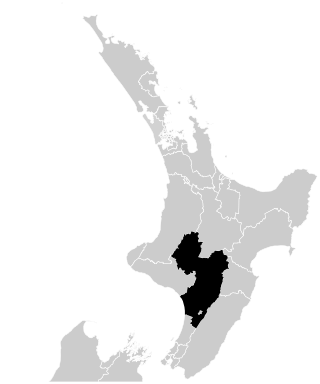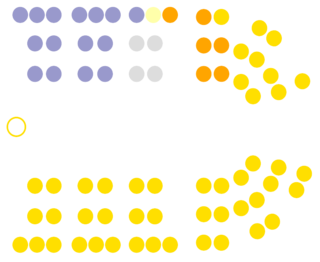
The 1893 New Zealand general election was held on 28 November and 20 December in the European and Māori electorates, respectively, to elect 74 MPs to the 12th session of the New Zealand Parliament. The election was won by the Liberal Party, and Richard Seddon became Prime Minister.
Ashburton was a New Zealand electorate, first created in 1881 and centred on the South Island town of Ashburton.

Palmerston North is a parliamentary electorate, returning one Member of Parliament to the New Zealand House of Representatives. The electorate was first formed for the 1890 election and was called Palmerston until 1938. The current MP for Palmerston North is Tangi Utikere of the Labour Party. He has held this position since the 2020 election.

Napier is a New Zealand parliamentary electorate, returning one Member of Parliament to the House of Representatives. It is named after the city of Napier, the main urban area within the electorate. The electorate was established for the 1861 election and has existed since. It has been held by Katie Nimon of the New Zealand National Party since the 2023 general election. It was held by Stuart Nash of the New Zealand Labour Party from the 2014 general election until 2023, when he did not stand for re-election.

Rangitīkei is a New Zealand parliamentary electorate, returning one Member of Parliament to the New Zealand House of Representatives. The current MP for Rangitīkei is Suze Redmayne of the National Party. She has held this position since 2023.

Whanganui is a New Zealand parliamentary electorate. It was first established in 1860 for the 3rd Parliament and has existed continuously since then.
Bay of Islands is a former New Zealand parliamentary electorate. It existed during various periods between 1853 and 1993. It was thus one of the original 24 electoral districts, and New Zealand's first ever MP was elected, although unopposed, in the Bay of Islands; Hugh Carleton thus liked to be called the Father of the House.
Waiapu was a New Zealand parliamentary electorate in the Gisborne – East Coast Region of New Zealand, from 1893 to 1908.
Francis Arkwright belonged to the British gentry. His first wife died after giving birth to a daughter, and he remarried. Arkwright represented East Derbyshire in the British House of Commons from 1874 to 1880.
Tuapeka is a former parliamentary electorate in the Otago region of New Zealand, from 1871 to 1911.
Inangahua is a former parliamentary electorate in the Buller District, which is part of the West Coast region of New Zealand, from 1881 to 1896. The town of Inangahua Junction, which gave the electorate its name, was located in the adjacent Buller electorate until 1887.
Bruce was a rural parliamentary electorate in the Otago region of New Zealand, from 1861 to 1922. For part of the 1860s with the influx to Otago of gold-miners it was a multi-member constituency with two members.
Pareora was a former parliamentary electorate in the Canterbury region of New Zealand for one electoral term in the 19th century.
Wairau was a parliamentary electorate in the Marlborough Region of New Zealand. It was one of the initial 24 New Zealand electorates and existed from 1853 until its abolition in 1938, when it was succeeded by the Marlborough electorate. The electorate had 13 representatives during its existence. The 1861 election in the Wairau electorate was notable in that a later Premier, Frederick Weld, was unexpectedly and narrowly defeated by William Henry Eyes.
Wellington Suburbs was a parliamentary electorate in Wellington, New Zealand. It existed from 1893 to 1902, then from 1908 to 1911, and from 1919 to 1946. The electorate was represented by six Members of Parliament.
City of Dunedin, during the first two parliaments called Town of Dunedin, was a parliamentary electorate in Dunedin in Otago, New Zealand. It was one of the original electorates created in 1853 and existed, with two breaks, until 1905. The first break, from 1862 to 1866, was caused by an influx of people through the Otago Gold Rush, when many new electorates were formed in Otago. The second break occurred from 1881 to 1890. It was the only New Zealand electorate that was created as a single-member, two-member and three member electorate.
Manawatu was a parliamentary electorate in the Manawatū-Whanganui region of New Zealand that existed during three periods between 1871 and 1996.

John Stevens was a Liberal Party Member of Parliament in New Zealand.

Robert Cunningham Bruce was a Scottish-born sailor, New Zealand politician and conservationist.

The 12th New Zealand Parliament was a term of the New Zealand Parliament. It was elected at the 1893 general election in November and December of that year.









